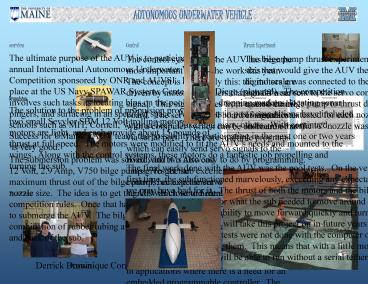AUTONOMOUS UNDERWATER VEHICLE - PowerPoint PPT Presentation
1 / 1
Title: AUTONOMOUS UNDERWATER VEHICLE
1
AUTONOMOUS UNDERWATER VEHICLE
Control
overview
Thrust Experiment
The ultimate purpose of the AUV is to participate
in the annual International Autonomous Underwater
Vehicle Competition sponsored by ONR and AUVSI.
It takes place at the US Navy SPAWAR Systems
Center in San Diego (pictured). The
competition involves such tasks as locating bins
on the pool bottom, dropping markers, locating
sonar pingers, and surfacing in an specified
space. Participants in past competitions have
included schools such as MIT, Cornell, Virginia
Tech, Duke, and many others. With continued
Success for UMaines AUV team, the possibility
of participating in the next one or two years is
very good.
The bilge pump thrust experiment was performed to
find the nozzle size that would give the AUV the
maximum thrust downward. A digital scale was
connected to the bilge pump, and a variety
of signals were sent to the servo control board
from the Lab PC. This caused the bilge pump to
thrust downward over the range that would
potentially operate at. The range of signals was
tested for each nozzle (ranging in diameters from
¼ to ¾). The results gave a clear indication
that the ½ nozzle was the right one to use.
The control system for the AUV has beenthe most
important part of the work this year. The
concept is essentially this the motors are
driven by motor controllers that run off a servo
signal. This signal comes from a servo control
board. The servo control board communicates
with a computer (which can be on-board or
not) via serial port. There are multiple
programs which can easily send servo signals to
the board, and it is also easy to do by
programming. This gives the sub excellent
proportional control, because the servo board
gives 255 signals which would ideally give the
motors 255 different possible speeds. The
computer used on board to control the AUV is the
Prometheus LC PC/104. A PC/104 is essentially a
PC with a different form factor. Due to the
small size, PC/104s are widely used in
applications where there is a need for an
embedded programmable controller. The
Prometheus LC is has a 486 MHz processor, 16 MB
of RAM, and 1 MB of Flash memory. Because the
AUV must be completely autonomous and powered by
on-board batteries, a feature which makes a
PC/104 very desirable is the low power
consumption. The Prometheus uses only 2 Watts
total power consumption.
Results
Propulsion
The solution to the problem of propulsion proved
to be two small Sevylor SBM 12 Volt trolling
motors. The motors are light, and each provide
about 15 pounds of thrust at full speed. The
motors were modified to fit the AUVs needs and
mounted to the wings. Along with the control
systems, these motors do a fantastic job
propelling and turning the sub.
Vertical Thrust
Pool Testing
The submersion problem was solved with two
Attwood 12 Volt, 2.9 Amp, V750 bilge pumps. To
get the maximum thrust out of the bilge pumps, an
experiment was performed to find the optimal
nozzle size. The idea is to get the AUV as
close to neutrally buoyant as allowed by
the competition rules. Once that has been
achieved, the bilge pumps have the thrust it
takes to submerge the AUV. The bilge pumps are
located inside the hull, and have a combination
of rubber tubing and PVC piping to connect them
to the nozzles at the front and back of the sub.
The final work done with the AUV was the pool
tests. On the very first time, the sub
functioned marvelously, exceeding any
expectations we may have had for it. The thrust
of both the motors and the bilge pumps were more
than enough for what the sub needed to move
around quickly. It proved to have the capability
to move forward quickly and turn sharply. This
gives the teams who will take this project on in
future years a great starting point. While the
tests were not done with the computer on
board, it was the PC/104 running them. This
means that with a little more programming, the
AUV will be able to run without a serial tether
attached.
The AUV Team
Derrick Brown
Dominique Corriveau































